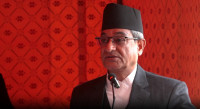National
Due process flouted while installing gold Jalahari at Pashupati
Anti-graft body’s weight measurement showed no major shortfall in Jalahari gold quantity.
Prithvi Man Shrestha
The Commission for the Investigation of Abuse of Authority (CIAA) on Sunday didn’t find any significant difference in the weight of the gold ‘Jalahari’ installed in the sanctum sanctorum of the Pashupatinath Temple, but the issue continued to spark debate as the Pashupati Area Development was found to have flouted due process.
Jalahari is the receptacle that covers the base of the Shiva Linga and collects and drains liquid offerings like water and milk offered to the Linga. The anti-corruption body, which has been investigating alleged corruption in the installation of the gold Jalahari, on Sunday removed it from the temple and weighed it. According to a CIAA source, it was measured at 107.46kg, which is close to the stated weight of 107.92kg.
Earlier, a complaint was registered at the CIAA claiming that around 11kg gold was missing from the Jalahari and the anti-graft body had initiated investigation into the matter.
“The installation of golden Jalahari invited controversy as the Trust officials installed it hastily and without following due process,” said Govinda Tandan, former member secretary of the Trust. “Also, the Jalahari was around half a kg lighter. Gold usually doesn’t get worn out so long as it is not mixed with other metals.”
Narottam Baidya, former treasurer of the Trust, said that the CIAA’s measurement established that the weight of the Jalahari was found to be less than what was claimed by the Trust. “The member secretary of the Trust had claimed in Parliament that he was ready to face even capital punishment if any discrepancy was found in the weight of the Jalahari,” he added.
Speaking at the National Concerns and Coordination Committee of the National Assembly on June 14, Member Secretary of the Trust Milan Kumar Thapa had said he was prepared to face the death penalty if there had been any embezzlement in the process of installing the golden Jalahari. Thapa said it was shameful to make accusations without a proper investigation.
Baidya is one of the two writ petitioners who moved the Supreme Court against the government’s decision to install the golden Jalahari. The earlier Jalahari was made of silver.
Even though the latest measurement of Jalahari weight showed no significant difference compared to the claimed one, according to the CIAA source, the Office of Auditor General said in its 59th annual report had also flagged the Jalahari installation process as non-transparent.
The Trust had purchased 103.77kg of pure gold from the Nepal Rastra Bank for Rs801.10 million in order to make the Jalahari. Then 2.89kg of copper, 1.249kg silver, 12.75gm zinc was added to the gold, taking the total weight to 107.924gm, the auditing body said referring to the Trust’s documents.
These metals are added to pure gold to make ornaments harder and more durable.
Of the total gold used in the Jalahari, 96.822kg was used for Jalahari proper while a golden band covering it weighed 10.976kg. “The Trust, however, failed to provide details of whether the gold that remained after the installation of the Jalahari proper was then used for making the outer band covering the Jalahari,” the auditor general’s report says.
Likewise, the Trust also failed to follow the Pashupati Area Development Trust (Second Amendment) Regulations while remunerating the craftsmen who made the Jalahari, according to the auditing body.
As per the regulations, the board meeting of the Trust decided to provide the wages to the craftsmen directly from donors. Instead, they should have been paid by the Trust after receiving donations in its own bank account.
There are no records of the donations for crafting the Jalahari, which was carried out in a rolling mill at Patan Durbar Square. “But the Trust failed to submit the agreement signed with the rolling mill and details of payments made to the 13 craftsmen,” the report says.
In January 2021, the then prime minister KP Sharma Oli had announced to provide Rs300 million to the temple to install the gold Jahalari and the Ministry of Culture had accordingly released the money.
Observers saw Oli’s announcement as part of his attempt to placate the Hindu constituency after President Bidya Devi Bhandari had, on Oli’s recommendation, announced snap elections after dissolving the House. On February 23, 2021, the Supreme Court had reinstated the House of Representatives, terming the House dissolution by the President ‘unconstitutional’.
Later, in February 2021, Baidya and Nikita Dhungana had filed a petition challenging the government decision to install the Jalahari. Just before the Supreme Court issued a stay order on the matter, the then President, Bidya Devi Bhandari, had already unveiled the 96.822kg gold adornment.
The writ petitioners had claimed that replacing the silver Jalahari with golden one was against the Ancient Monument Preservation Act-1956.
Section 12 of the Act says, one who destroys, demolishes, removes, alters, defaces or steals is subject to punishment with a fine of Rs25,000 to Rs100,000 or with an imprisonment of 5-15 years or both after recovering an amount equal to the claimed amount for damage to the ancient monument/archaeological object concerned.
Meanwhile, lawmakers from the ruling parties including Nepali Congress Lawmaker Pradeep Poudel and Maoist Centre lawmaker Devendra Poudel on Monday called for parliamentary investigation of the Jalahari dispute.




 10.12°C Kathmandu
10.12°C Kathmandu















